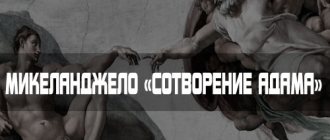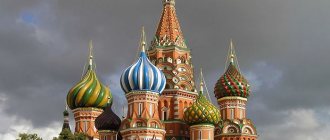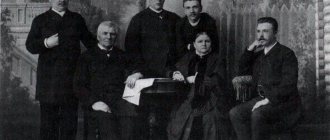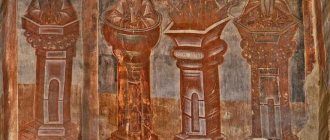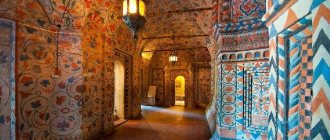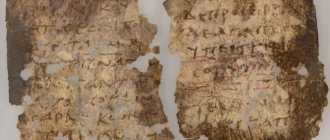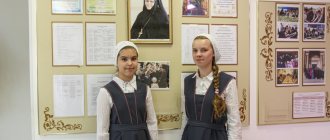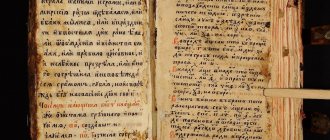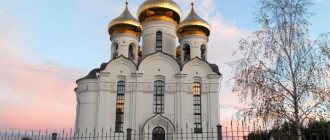The interior decoration of the temple should not look “like the Bible for the illiterate,” as Gregory the Theologian put it.
Each temple must have its own face, while observing the laws of canonical painting.
Each individual element of the temple's painting is part of an organic, indivisible whole, built on the basis of certain principles. To create a wall painting in a temple, an artist must team up with a theologian. For example, the hieromonk and painter Dionysius, in his treatise “Erminia or Instructions in the Art of Painting,” gives the first advice for an icon painter
:
“Whoever wants to learn painting should make a first start and practice drawing and drawing for some time without any measurements until he gets the hang of it. Then let a prayer be made for him to the Lord Jesus Christ before the icon of Hodegetria.”
The following is the text of the prayer, which must be read by a beginner who dares to embark on the path of an artist in painting the walls of the temple.
Having said the prayer, you can get down to business
- The painting of the temple begins from the dome and drum of the temple from top to bottom, going down to the main volume of the church quadrangle.
- Then the painting of the temple altar, on the choirs and under the choirs begins.
- The porch of the temple, the entrance, and the lower multi-figure compositions in the quadrangle are painted.
- Finally, ornaments are painted at the very bottom of the temple.
Starting work from the dome of the temple, the artist seems to show with his work what is most important in the temple of God, gradually descending in the process of work to the lower, ground level, the height of a man.
For responsible work in a place of worship, a team of well-working artists is needed.
Materials for artistic work can combine several types of paint, depending on the composition. For example, you can use some paints for figured compositions and others for ornaments.
Suitable silicate, oil paints, art acrylic
.
Let us turn again to the work of Hieromonk Dionysius:
“Which paints are used for wall painting and which ones are not used
Icon white, copper varnish, blue paint (lahuri), varnish and arsenic are not used for wall painting, but other paints are all used. However, you need to know about cinnabar that if you paint the outer part of the temple in a place where the wind blows, then do not put it, because it turns black, but replace it with light brown paint. If you are painting the inside of a temple, then add a little wall white and Constantinople ocher to the cinnabar, and it will not turn black.”
Program for painting the dome and vaults of a Christian church
General information
Davidova M. G.
Early Byzantine period
Images of the Savior in the dome of the temple in the early Byzantine period, that is, in the IV-VII centuries. are not so common, due to a number of reasons. Firstly, the metaphorical language of early church art did not always allow direct depictions of sacred persons and events, even after the formation of the empire of Constantine the Great, when Christianity became the official religion. Allegorical symbols accepted in early Christian art, such as the Good Shepherd, the Lamb and other allegories of Christ, hiding the secret meaning of the doctrine from the uninitiated, were widely used in temple decoration later, although the urgent need for the sacred depiction of Christian images disappeared.1
Secondly, not many domed structures have survived from the early Byzantine period to our time (the churches of the St. Apostles, St. Irene, St. Sophia in Constantinople, Christian martyrias, baptisteries, etc.), since among the most common form of temple architecture of this period can be called a basilica. At the same time, the internal images of Byzantine churches, destroyed during the era of iconoclasm, have not reached our time.
We have only indirect evidence about images, for example, from the Justinian era, known in descriptions. In particular, it is known that the mosaic decoration of Sophia of Constantinople under Justinian II (565-578) consisted of a plot cycle revealing the theme of the Heavenly glory of Jesus Christ, emphasizing His Divine dignity, in connection with the victory over the heretics Arius and Nestorius on the First Ecumenical Council. There were probably no figurative images in the dome, since the Cross was placed here under Justinian I.2 Almost all the mosaics of this time were destroyed in the iconoclastic era. Known only from descriptions, monumental icons of St. Sophia from the 6th century. cannot be assessed from the point of view of iconography.
A different historical situation developed in Italy, where the wave of iconoclastic heresy did not reach and where unique examples of mosaic painting of the early Byzantine period were preserved. Before the establishment of classical temple decoration in the post-iconoclast period, the tradition of decorating the dome had much in common with the decorative decoration of the altar conch.
Chapels, tombs (mausoleums) or baptisteries could be covered with a dome (vault). In the latter case, we have to talk about a fairly flat and extensive dome, on the inner surface of which full-length figures of saints could be placed. An example is the mosaics of the Orthodox and Arian baptisteries in Ravenna (5th century). Both mosaics, representing the etimasia, the procession of the apostles among the trees of paradise (date palms are a symbol of paradise), convey in a concentrated form the tradition of altar decorative programs.
The theme of the procession of the saints to the Prepared Throne, to the Heavenly Jerusalem, to the Garden of Eden with the river of life (spiritual Jordan) appears in the 5th-7th centuries. in the altar concha and on the triumphal arch (the churches of San Paolo e Framenti (5th century), St. Cosmas and Damian (6th century)).
Images of Christ are present in both baptisteries of Ravenna as part of the composition “The Baptism of the Lord.” The Savior is presented here in the form of a Youth, which corresponds to the early Christian tradition, known from catacomb paintings. Moreover, if in catacomb painting the theme of Sacrifice is emphasized, then in early Byzantine images - the eschatological aspect.3
It is interesting that the composition “Baptism of the Lord,” representing the New Testament Theophany (Epiphany), is a semantic parallel to the traditional altar compositions of the early Byzantine period, which are predominantly theophanic.4
Vaults of smaller volumes could be decorated, like the vault of the mausoleum of Galla Placidia in Ravenna (5th century): on the blue starry sky in the center there is a golden cross, in the corners there are symbols of the four Evangelists. The cross, etomasia, tetramorphs and heavenly powers are constant elements of the upper sections of the mosaic decoration of the conch or triumphal arch of the early Christian period (Church of St. Pudenziana in Rome (VI century), temple of San Apollinare in class in Ravenna (VI century), etc.) . These motifs can vary, being components of the decorative decoration of the chapel vault or altar vima.
In the mosaics of Ravenna there are not only direct images of the Savior, but also allegorical images. In particular, at the zenith of the vault of the Church of San Vitale (521-532) in Ravenna one can see Angels and the Mystical Lamb,5 the image of which echoes two other icons of Christ, also presented in the altar. On the one hand, Christ in a masculine type - with long hair and bridal hair - is depicted in the upper part of the triumphal arch. Here, on the inner surface of the arch, there are mosaic icons of the apostles in medallions, as well as images of the selected martyrs St. Vitalia, Gervasia and Protasia. On the other hand, the composition with the Lord Emmanuel in the altar conch, seated on a sphere, includes figures of Angels and saints. The image is complemented by the motif of the four rivers of paradise. The latter feature brings the altar composition of the Church of San Vitale closer to the “Traditiono Legis” (“Transmission of the Law”), which is characterized by a combination of images of Christ, the Most Supreme Apostles, the Mystical Lamb and the rivers of paradise. Similar images can be seen both in catacomb paintings (the catacombs of Peter and Marcellinus) and on objects of decorative and applied art (the Buonarotti vessel).6 Both the Tradition Legis and the composition with Emmanuel in San Vitale have an eschatological meaning: the cross-shaped halo of Christ Emmanuel and the Book of Seven Seals are symbols of the apocalyptic Lamb.7 Thus, the three images of Christ in the altarpiece of San Vitale unfold the same theme in the architectural space, being different elements of the same symbolic narrative. The image of Christ with the apostles in early Byzantine art could have been replaced by images of lambs.8 Savior Emmanuel in the conch is represented with the symbolic attributes of the Mystical Lamb of the Revelation of John the Theologian. That is, it is Revelation that in this case is the key to understanding the images. The central point and a kind of epicenter of these meanings is the image of the vault of the vima, which can be called a metaphorical “reflection” of the altar and the triumphal arch.
Another version of the allegory about Christ at the zenith of the church vault appears in the archbishop's chapel of Ravenna (494-519). In the medallion of the vault there is a monogram of the Savior, composed of the Greek letters “I” and “X” aligned at the centers. The monogram of Christ or chrism, supported by Angels and surrounded by tetramorphs - allegorical images of the four evangelists in the form of animals from the Old Testament revelation, is to some extent a replacement for the icon of the Lord in the vault. This can be assumed based on the fact that the combination of all of these motifs is usually found in so-called theophanic compositions, where the central image is the Son of Man from apocalyptic visions.
The sign of the name of the Lord can be associated with the symbol of the cross, which is one of the most common images filling the dome or conch. Indeed, chrisma can be called its synonymous replacement, which is obvious when comparing different designs of the Christogram, evolving from a simple image of the letter “X” to complex combinations of several Greek letters with the Cross.9
The images of the archbishop's chapel vault echo other images of the church, since the theme of the Cross appears here repeatedly. In the lunette of the church, for example, you can see Christ the warrior trampling a lion and a serpent. On Jesus’ shoulder is the Tree of the Cross, which in this case is a weapon that defeats the forces of hell. In the altar conch there is a mosaic Cross on a starry background, which is the result of restoration work carried out in 1914-1920. based on surviving fragments.
Thus, the Lamb, the Cross and the monogram of Christ are to some extent the equivalent of the image of the Savior in the early Byzantine tradition.
Images of the dome in the post-iconoclastic era
In the IX-XI centuries. Christ is found in the dome in two main forms: as part of the “Ascension” composition (for example, the dome of the Church of St. Sophia in Thessaloniki, 885) and in the form of Christ Pantocrator (the Church of the Assumption in Daphne, etc.). Although the main direction of the post-iconoclastic temple program is determined by the theme of the Incarnation,10 which is due to the nature of the arguments in the anti-iconoclastic polemics,11 the images of the dome can be interpreted in the context of those traditions that were laid down in the early Byzantine era. Thus, the iconography of the “Ascension” with the image of Christ seated on an apocalyptic rainbow is reminiscent of theophanic compositions known in an earlier period.
A characteristic feature of the iconography of Christ Pantocrator (that is, Christ the Pantocrator) is the image of the blessing right hand of the Lord and an open or closed book. The Savior is dressed in a tunic and himation. The sewn vertical stripe on the tunic - the clav - symbolizes “the purity and perfection of the human nature of Christ,” it is also interpreted “as a sign of messengership, a sign of the special messianic role of the Savior.”12 The tunic “has shades of red, and the himation is blue. The combination of these two colors symbolizes the earthly – human – and heavenly – Divine nature of the Savior.”13
As an example of the image of Christ Pantocrator in the dome, one can cite the mosaic icon of St. Sophia of Kyiv. Lord Pantocrator “is depicted up to his chest, in a purple tunic and blue himation, with a closed book; The cross-shaped halo is decorated with imitation precious stones lined with smalt. The entire composition is closed in a circle, along the outer edge of which there is a rainbow glow. The rainbow symbolizes both the heavenly spheres and the Covenant between God and man.”14 The mystical rainbow is spoken of in the book of the prophet Ezekiel (Ezekiel 1: 27-28). It is interesting that it is the images from this prophetic book that are the starting point for the iconography of early Byzantine theophanic compositions. Thus, it can be assumed that the image of Christ Pantocrator has a theophanic meaning.
It should also be noted that the multi-colored glow, which is a recurring motif in altar mosaics of the 5th-7th centuries. (the churches of St. Apollinaris in Classe in Ravenna, St. Cosmas and Damian in Rome) can be interpreted in the context of the theophany of the Lord on Tabor, when the Transfiguration of the Savior is accompanied by rays of uncreated Light. The same symbolism can be attributed to the rainbow circle around the face of Christ in the dome of St. Sophia of Kyiv.
Old Testament revelations about the Epiphany in the V-VI centuries. sometimes depicted in the altar apse (mosaic of the Church of Hosios David in Thessaloniki, 5th century). (Polevoy, 1973: ill. on pp. 59-59). As mentioned above, the themes of the apse and dome sometimes overlap.
So, the theophanic theme in the dome can be perceived as the reality of the Transfiguration. Some researchers have pointed out a similar interpretation of the image of Christ Pantocrator. In particular, Thomas Matthews tends to see "transformative symbolism" of a liturgical nature in images of the Eastern Christian dome. The researcher emphasizes that the stern appearance of the Savior in the Byzantine dome is associated with the theme of the need for transformation for fallen man. For example, in the Karanlik-Kilise Church in Goreme, the domed icon of the Almighty is framed by the accusatory words of the Psalm “whether he understands or seeks God” (Ps. 52: 3). During the service under the dome of the church, the Eucharistic transformation of believers takes place.15
That is, one of the possible explanations for the symbolism of the image of Christ Pantocrator is its interpretation in a liturgical context, since in church monumental painting the inscriptions around this icon often reflect the texts of the Liturgy. For example, in the Church of the Assumption on Volotovo Field (1352), there was an inscription around the image of Christ in the dome: “Holy, holy, holy is the God of Hosts, filling heaven and earth with Your glory. Hosanna in the highest. Blessed are the cities (coming, going - D.M.) in the name of the Lord. Hosanna in the highest" (Isa. 6:3; Matt. 21:9). (Lifshitz, 1987: 495). This text is sung shortly before the Transubstantiation of the Holy Gifts. In this regard, it can be considered that the icon of the Savior in the dome reflects a number of meanings inherent in the Holy Gifts. This is the Suffering of the Savior, His Resurrection and the Transformed Being of the Second Coming, since the Body and Blood of Christ is the Body of the Savior resurrected and glorified (Uspensky, 1993: 14).16
So, the images of Christ in the vault or dome of an Eastern Christian church of the 5th-11th centuries undergo changes associated with iconography (allegorical and direct images of Christ, Christ in the form of a Youth and in a masculine type). The general theological meaning of the image also changes in shades: the eschatological interpretation is complemented by interpretation in the context of the “transformative symbolism” of the Liturgy.
Compositions “Ascension” and “Christ Pantocrator” in the dome
Some researchers believe that the composition “Christ Pantocrator” is genetically related to the “Ascension”, has the same meaning and is, as it were, a short iconographic version of it. Images of Christ Pantocrator are gradually replacing the “Ascension” in the system of the cross-domed church, which has less extensive domed surfaces in comparison with the era of Justinian (Sophia of Constantinople). (Demus, 1947: 19). Christ Pantocrator was depicted in a mandorla supported by angels, which strengthened the similarity of the image with the composition “Ascension”. The icon of the Pantocrator in the dome represents, according to this view, Christ in glory after the Ascension (Demus, 1947: 19). Based on all that has been said, it is clear why in the classical monuments of Byzantine monumental painting “The Ascension” and “Christ Pantocrator” are not found within the same temple space. The exception is the provincial (in relation to Byzantium) tradition (San Marco in Venice) (Demus, 1947: 19).
Both options for decorating the dome are eschatological in their content. In the narrative from the Acts of the Apostles about the Ascension, the theme of the Second Coming of the Savior arises (see: Acts 1: 11). The same idea is expressed iconographically when the vision of the Son of Man seated on a rainbow from the Apocalypse (Rev. 4: 3) appears both in the image of the Last Judgment (mosaics of the Florentine Baptistery, 13th century) and in the “Ascension” (Sophia of Thessaloniki, 9th century).
If we adhere to the point of view about the symbolic proximity of the compositions “Ascension” and “Christ Pantocrator”, the latter image can also be associated with the theme of the Second Coming. This idea is confirmed, for example, by the prophetic inscriptions of the head of Sophia of Novgorod: “Behold, the Lord Almighty Himself is coming” (Mal. 3: 1-2). “God will come from the south” (Hab. 3: 3) (Lifshits, 1994: 158).
Page 1 - 1 of 4 Home |
Prev. | 1 | Track. | End | All © All rights reserved
The main stages in the work of painting the walls of the temple:
Marking for the temple painting
- Plastering, priming and painting walls;
- drawing a wall, tracing;
- making linear drawings on the wall;
Illustration of the main architectural elements
- Drawing panels, backgrounds;
- making paper stencils for drawing ornaments;
- painting with a brush, finishing.
Painting of the temple dome, ornaments and images of archangels
- Drawing backgrounds under ornaments and images;
- figured compositions of saints in decorative design;
- using gold paint (for example, Keim Soldalit matte paint).
Painting under the choir platform
Architectural elements and ornaments are applied using tracing paper and stencils. Stencils for fonts in the Old Church Slavonic language are used.
Altar painting
The eastern walls of the altar and apse are painted strictly according to the canon. In the central part is the image of the Lord Pantocrator seated on the throne, or the image of Christ giving communion to the twelve apostles.
A large temple may have several altars and altars. Altar painting is most often done with oil paints to achieve natural colors and shades.
Three cycles of painting
The painting of the Church of the Nativity of the Virgin Mary reflects three levels of meaning. They correspond to pictorial cycles.
The first, Christological, reveals the story of the Sacrifice. It is located in the altar - the “holy of holies” of the temple, where the Eucharist is celebrated.
On the eastern vault - where in a regular-sized church there would be a concha (a semi-dome-shaped ceiling over the semi-cylindrical parts of the buildings) - there is a monumental half-length image of the Mother of God with Christ Emmanuel in a medallion - the “Sign” or “Incarnation” type.
Below is the “Eucharist”. Under the ciborium behind the throne stands the sacred Christ. In his left hand He holds the prosphora (Lamb), and with his right he blesses. The apostles approach Him from both sides. On either side of the throne on which the Chalice stands are two angels in white vestments with ripids in their hands. The “Eucharist” recalls the Last Supper and at the same time illustrates the liturgy, which is celebrated on an earthly and at the same time heavenly altar.
Of course, the altar depicts the “Crucifixion”. This image suggests that the Bloodless Sacrifice of the liturgy is offered in remembrance and as an image of the suffering and atoning sacrifice of Christ. The Washing of the Feet and the Last Supper also reflect the idea of the Eucharist.
The altar depicts gospel events - from the “Resurrection of Lazarus” to the “Assurance of Thomas” and the “Descent of the Holy Spirit”. Thus, the cycle reveals the theme of the Divine Economy and refers to the most important Lenten and Easter services.
The second cycle is the Theotokos. His subjects are located in front of the altar. It includes scenes from the life of the Mother of God from the Nativity to the Assumption and two feasts of the Mother of God - “The Intercession” and “The Position of the Robe of the Mother of God in Blachernae”. The Nativity of Our Lady occupies the most prominent place - near the altar, because the temple was consecrated in honor of this holiday.
Examples of wall painting in Orthodox churches
Annunciation Cathedral (Moscow Kremlin)
The Annunciation Cathedral of the Moscow Kremlin is small in size, because it was intended only for the Grand Ducal family.
The cathedral was built in 1489 by craftsmen from Pskov.
The icon of the Mother of God from the Deesis rank, at the entrance to the cathedral from the western gallery, seems to invite you to enter the church.
Unique surviving paintings made by the son of Dionysius, the artist Theodosius, with his brethren. A medieval artel, a nameless brethren, created for us a unique painting in which the faces look as if they were alive.
Artists of those early years were obliged to make their own paint for painting.
Let's return to the monumental wall painting of the Annunciation Cathedral. It was decorated with frescoes three times during the reconstruction process.
The painting of the cathedral is called verbose, consisting of cycles. Each cycle consists of detailed plots, which are complicated by the addition of episodes and characters. The painting of the walls of the Annunciation Cathedral of the Kremlin has been preserved since the time of Ivan the Terrible. There are unique characters that are not usually depicted in Orthodox churches
:
- Greek sages Aristotle (with a scroll on which is written “First God, then the word and the spirit, and with him is one”), Homer, Plutarch, Menander, Ptolemy, Anaxagoras. The Hellenic sages seem to proclaim the birth of Christ.
- Ancient Roman prophetesses Sibyls.
Hagia Sophia (St. Sophia Cathedral), Kyiv
The heart of the Sofia Reserve, an 11th-century Orthodox church in the Ukrainian Baroque style. The temple was built by Prince Yaroslav the Wise and preserved unique fragments of mural painting from the 17th-18th centuries, more than 3000 m2.
In ancient times, all the side walls of the St. Sophia Cathedral were decorated with paintings with water paints on wet plaster. In the 17th century, the galleries, towers and choirs were renovated with glue paint. The damaged frescoes were plastered and whitewashed.
The new demands of the era led to the fact that in the 18th century new oil images were painted on top of the frescoes. A century later, the new oil painting was cleared away. The subjects of ancient frescoes were repeated.
The cathedral, listed as a UNESCO World Heritage Site, has undergone modern restoration work. Ancient frescoes have been restored, and where they were lost, paintings from a later period are left.
In the Hagia Sophia, the blue, deep azure on the walls of the temple is striking. How did temple painters achieve this in ancient times? This is what Hieromonk Dionysius writes in his work “ Erminia, or instruction in the art of painting”
»:
“Like illuminating walls with azure.
Put the azure on the stove, add to it a little chenille (), called hinti (indigo), so that the azure does not mold on the wall, and as much as you put in the chenille, mix in the same amount of wall white, wipe it all off thoroughly and collect it in a cup. Then first prime the wall with white washed with linseed oil, then cover it with black paint, and finally light it with azure. Its reflection is done both on black umra and on dark brown paint.”
In the temple, created under Yaroslav the Wise, there is a unique fresco “Group portrait of the family of Yaroslav the Wise.” In the fresco, Yaroslav holds a model of St. Sophia Cathedral, next to the prince is Yaroslav’s wife and Princess Irina. Yaroslav and Irina were followed in a solemn procession by sons and daughters. From this large composition, four figures survive on the south wall of the central nave and two on the north.
According to legend, Prince Vladimir and Princess Olga also stood near the figure of Christ, to whom the princely family was walking.
Holy Trinity Ipatiev Monastery
On the banks of the Kostroma River, not far from its confluence with the Volga, the Holy Trinity Ipatiev Monastery with a stone Trinity Cathedral with two chapels was founded in the 15th century.
The fresco cycle of the Trinity Cathedral covers the walls as if with a carpet. They are arranged in five tiers and the entire cycle consists of eighty-one compositions. A team of icon painters, led by the famous Gury Nikitin and Sila Savin, painted the cathedral in three months of 1685. 18 people managed to complete this grandiose work! Pictures of the artel’s unusually selfless work involuntarily arise in the imagination. Painting frescoes in the Trinity Cathedral was the final chord of the great master.
Guriy Nikitin lived his life as a bore, was an ascetic and ascetic. In a 17th-century scribal book, the courtyard of the icon maker Guriy Nikitin is also named, about whom there is only one phrase: “His belongings are good,” - that is, he was a very poor man.
“The least of the painters,” as master monumentalists modestly styled themselves at that time, painted the walls of churches in many cities, including the Moscow Kremlin: the Assumption and Archangel Cathedrals. In the Kremlin of Rostov the Great - the Assumption and Resurrection Church.
One of the most famous frescoes of the Ipatiev Monastery is “ The Last Judgment
"on the western wall of the Trinity Cathedral. When you enter the temple, you freeze at the amazing sight of this monumental work. This is one of the most ancient frescoes of the cathedral and dates back to 1654.
The example of icon painter Gury Nikitin clearly shows what requirements were placed on painters creating frescoes on church walls. At all times, artists working in churches must value their calling.
Nowadays, when more and more temples appear, there are many orders for such work. Prices depend on the amount of work and the complexity of the images. Of course, it is impossible to find an ascetic and ascetic like Gury Nikitin today, but it is quite possible to find a good artist.
Church of the Nativity of the Virgin Mary: heavenly glow underground
The Diveyevo Church of the Nativity of the Blessed Virgin Mary is unusual. The builders “undermined” it under the upper Church of the Nativity, which was erected a year earlier. This happened after, according to legend, the Most Holy Virgin appeared to Saint Seraphim of Sarov and reproached the elder: “You honored My Son, but forgot Me!”
The Church of the Nativity of Our Lady is, in fact, a crypt, the tomb of the Venerables Alexandra, Martha and Elena Diveevsky. Low arches, powerful pillars, twilight - the temple resembles a catacomb. In such a chamber room, the painting system unfolds only horizontally, but in compliance with the hierarchy of meanings.
Since the walls in the temple are low, only two and a half meters, the scale of the figures for monumental painting is very small, if not tiny - 50-70 cm. The icon painters worked using the labor-intensive technique of miniature painting.
The abbess and the sisters of the Diveyevo monastery asked the Tsargrad artists to paint in the style of the early 14th century, using as a basis the mosaics of the Kariye-Jami temple from the ensemble of the monastery in Chora (Constantinople).
For the head of the workshop, Dmitry Trofimov, this request was a real gift, because Kariye-Jami is one of the artist’s most favorite temples. An extended cycle of the Theotokos has been preserved in the Chora. In addition, in comparison with other churches of Constantinople, it is quite intimate, and the scale of the mosaic subjects is small.
Theotokos cycle
A golden background was chosen for the painting. On the one hand, he creates a symbolic space - a world in which the radiance of Divine light is dissolved. In this luminous cosmos the events of Sacred history unfold. On the other hand, lamps, furniture, candle flames are reflected in the solid golden surface - and the vaults seem to rise, the feeling of a basement disappears.
Golden backgrounds are combined with a light base, pillars and floor, the design of which “Tsargrad” developed together with mosaicists. This line is supported by light benches along the walls.
The artists tried to get closer to the Byzantine model in every detail. For example, the base in the Diveyevo church is marble, only in the Chora the marble is real, and in Diveyevo it is a skillful imitation. It is not just painted with a brush, but made using stucco technology so that it is indistinguishable from a genuine marble surface. The craftsmen transferred the Kariye-jami ornaments to the temple as accurately as possible, naturally changing the scale and color.
The artists did not differentiate, but combined the compositions - one plot smoothly flows into another under the same golden skies. Halos echo the background, light clothes and rocks echo the marble
